How And Where to Buy Fancy Cut Diamonds?
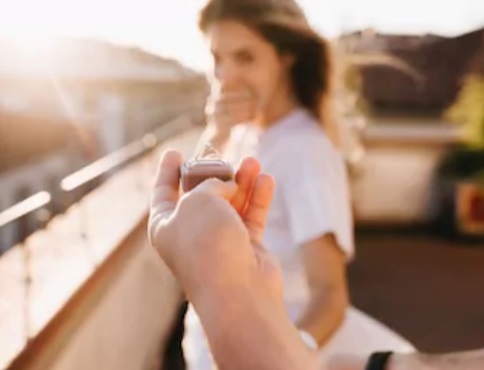
When it comes to buying fancy cut diamonds, the selection process for a well cut diamond can quickly overwhelm a first time shopper. This is because fancies are very difficult to define using proportion parameters and there are various factors which affect their appearance.
In this write up, I’m going to show you the exact steps to cherry picking the best diamond within your budget and where to get the best value for your money when buying a fancy shaped diamond ring.
2 Reasons Why Well Cut Fancy Shape Diamonds Are So Difficult to Buy
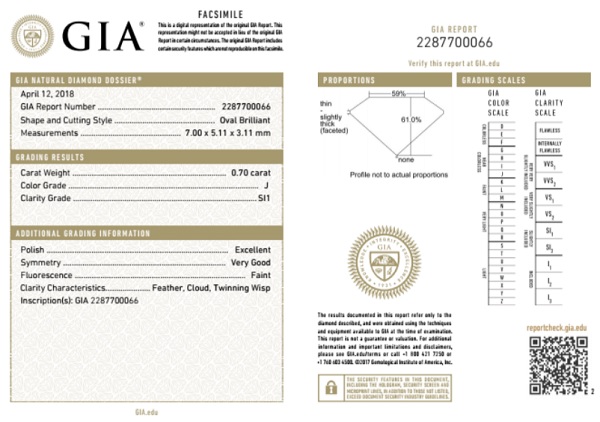
Screenshot of fancy cut diamond grading report from GIA
Unlike round diamonds, the GIA grading reports for fancy shape diamonds do not contain a cut grade which provides an indication of its light performance. This is the primary reason why many beginners find it hard to assess diamonds as there is no reference or cut grading system to help in decision making.
If you’ve done some research on Beyond4cs.com, you might had come across tables of recommended proportions for the various shapes with guidelines for table % or depth %. The thing is, tables and figures like these are only useful as a “first screen” and the criteria listed are not cast in stone.
The second reason is that the majority of fancy shaped diamonds in the market are poorly cut and your chances of finding a well cut diamond in a store is very slim.
To make matters worse, the special lighting employed by jewelry stores are designed to make even the poorest cut diamonds sparkle. This is the main reason why some diamonds seem to lose their sparkle and look totally different once they are out of the store.
With that said, don’t get your hopes too high. Even if your local jeweler does carry inventory of a certain fancy shape you are interested in buying, they usually hold a very limited stock with few choices (and probably badly cut ones) for you to choose from.
The truth is, the odds of finding a well-cut diamond are stacked against the general shopper who has limited experience and knowledge. To make rational decisions, you’ll require additional data and tools to help you determine the light performance and optics.
The #1 Mistake That Consumers Make When Buying a Diamond Ring
The biggest mistake that you can make when shopping for a diamond ring is to “buy blind” and that means you make a purchase based solely on a grading report and nothing else.
Let me illustrate this with an example. Imagine you are shopping for a cushion cut diamond and come across a particular diamond that meets your budget and specifications on a website or via a recommendation from your local jeweler.
Now, you are only given the following information based on a GIA lab report.
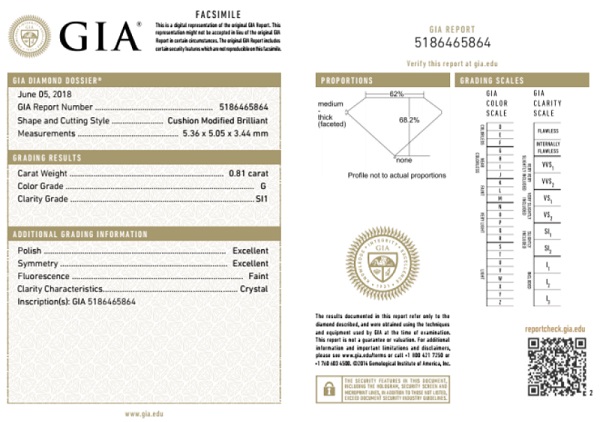
On paper, everything might appear OK and the stone might seem to be a decent choice. Now, if you were to go ahead to make the purchase thinking that you made a great buy, imagine how you would feel if you opened up the parcel and saw this?
Would you still feel the excitement of receiving your brand new diamond that looks like this?
Contrary to what you may think, the phenomenon of buying diamonds blind occurs regularly in physical brick and mortar stores as well.
For reasons I stated about having very limited inventory on hand, most local jewelers attempt to work around this by offering to bring in a diamond based on your desired specifications.
They do this by requesting full payment upfront or imposing a shipping fee or requiring a non-refundable deposit before you can “see” the diamond in person. What happens here is that all the RISK is placed on you and they simply “buy” the diamond blind on your behalf.
It’s silly if you think shopping in a physical store in this manner would give you the peace of mind you think you are getting.
Sadly, that’s how the majority of uneducated diamond shoppers actually buy their engagement rings. It perplexes me how people can spend thousands of hard earned dollars without evening “seeing” the diamond. It’s not very smart at all.
Where Are the Best Places to Buy Fancy Cut Diamonds?
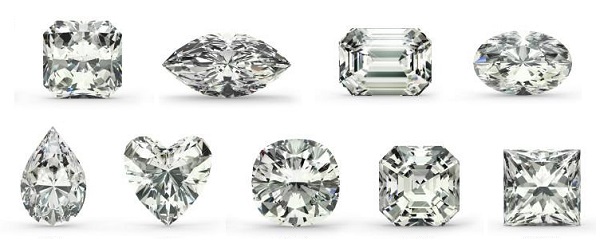
The key to choosing a fancy cut diamond is to be able to see and review the diamond for its appearance and brilliance. The best way to do this is to go online and work with vendors who provide tangible data and offer a sizable inventory for you to cherry pick from.
Now, I want you to get this straight. I’m not referring to the bad online retailers where they only list an inventory of stones and expect you to make a selection based solely on the information extracted from grading reports.
Instead, I would recommend shopping at some of the best vendors in the world that offer HD videos and analytical data for their listings. The ideal choice of vendor may differ based on the shape of the diamond you are looking for:
- James Allen for all types of fancy shape diamonds
- Blue Nile for cushion, emerald and large carat sizes
- White Flash for ideal cut princess diamonds
- Brian Gavin for ideal cut cushion, emerald and princess diamonds
Why I Personally Recommend These Online Diamond Retailers?
Here’s why… Every diamond is uniquely different and no 2 diamonds are alike even if they share the same exact specifications on a grading report. When it comes to fancy cuts, subtle differences in clarity and cut can make or break a deal.
This is where vendors like James Allen stand out compared to traditional businesses in the industry.
They feature magnified HD videos of every single stone in their inventory. The user-friendly video technology enables you to inspect their diamonds in far greater details than you ever would at any other physical jeweler.
With this feature itself, they have made it so much easier for you to navigate their inventory, select and shortlist possible candidates for purchase.
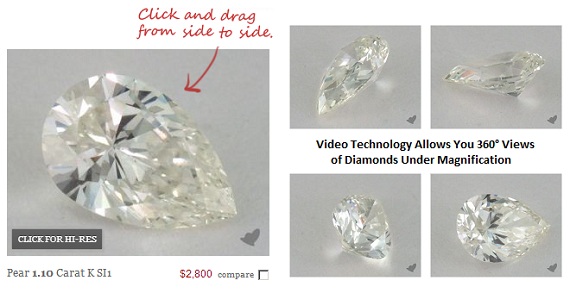
Besides having lower prices, one of the main advantages of going online is the huge selection of diamonds that can be made available to you at the click of a few mouse buttons. Instead of the usual 1 or 2 options you can get at your local store based on your required specifications, online vendors can easily allow access to more than 100s of stones for you to pick from.
Using the ASET to Help You Analyze and Make Educated Decisions
Photographs and videos are crucial in the selection process for a fancy cut diamond as they allow you to see how the diamond looks like in real life. Here’s where things get even better.
When it comes to cherry picking the most brilliant and best performing stone, you need to go beyond photographs or videos. One such tool that will offer you an objective analysis of how well cut a particular stone is the Angular Spectrum Evaluation Tool (ASET) where you get to see how the diamond interacts with light.
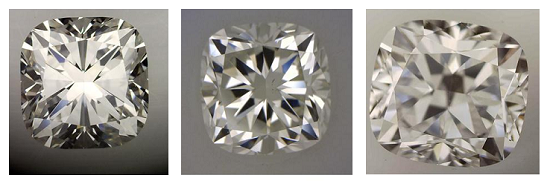
How do you decide which is the best amongst them in terms of optics?
Based on magnified pictures above, it is very difficult to tell which diamond will have the best performance and look the most brilliant. However, the use of an ASET image will allow you to objectively evaluate performance even if you are a complete beginner.
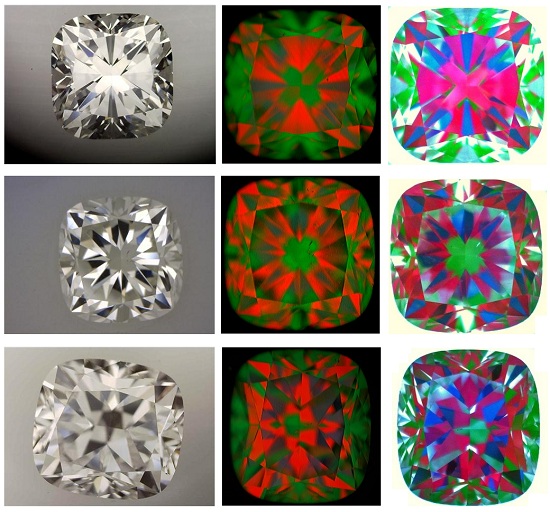
Black field ASET images & White field ASET images
In an ASET image, we want to see lots of reds that indicate light return. Green is OK and blue adds contrast to the outlook. What we don’t want to see is whites or blacks (indicates light leakage). From the example above, the first stone is obviously lacking in terms of brilliance as there is a significant amount of light leakage at the 4 edges of the diamond.
Between the other 2, my preference goes to the 2nd stone as we see the reds reaching to the edge of the stone. This edge to edge brightness will make the stone look larger than it is. Also, based on the ASET image, you can also infer the contrast, patterning and scintillation of the diamond.
More Examples of ASET Images For Other Fancy Shapes
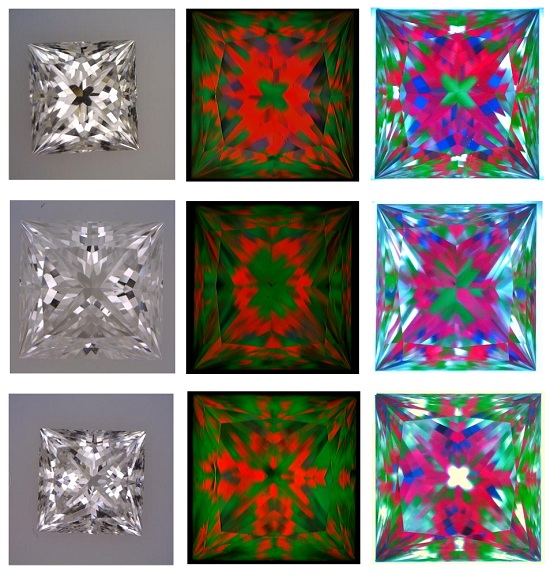
Pretty obvious that the top most princess cut has the best light performance
Corresponding ASET Photographs For Heart Shaped Diamonds
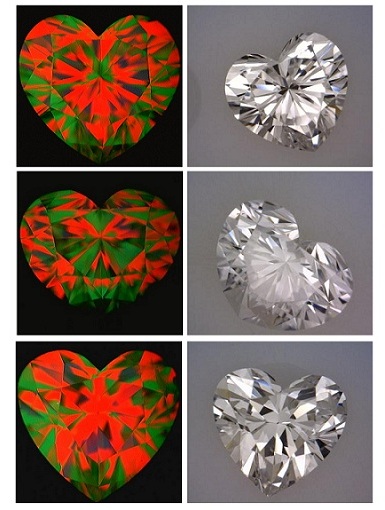
In the above example, the 2nd stone is the clear loser and doesn’t perform.
Did you know that most other retailers don’t even provide basic photographs of their inventory, let alone being able to provide you with ASET data for critical evaluation. For these reasons, I recommend you to work with vendors like James Allen, Blue Nile and White Flash.
Besides having high resolution videos of every single diamond in their inventory, they also have the proper equipment to capture ASET images. More importantly, they are offering this free service to consumers as a value add.
Try doing that with any other vendor and you’ll likely get charged hundreds of dollars for shipping fees just to get a diamond evaluated.
In my opinion, this is a very big plus point as you don’t buy sight unseen and get to browse in a completely stress-free environment.
6 Simple Steps to Shopping for a Fancy Cut Diamond
Step #1 – Use search tool to filter diamonds based on your budget / 4Cs.
Step #2 – Inspect diamond for eye-cleanliness and shape appeal with the videos.
Step #3 – Review ASET photographs to determine optical performance.
Step #4 – If ASET images are not listed, contact support & request for them.
Step #5 – Cherry pick and choose the best stone based on tangible data!
As a recap, I recommend the following vendors and classified them based on their specialties for different types of shapes:
– James Allen for all types of fancy shape diamonds
– Blue Nile for cushion, emerald and large carat sizes
– White Flash for ideal cut princess diamonds
– Brian Gavin for ideal cut cushion, emerald and princess diamonds
For new and inexperienced diamond shoppers, I know this article might be a handful of information to digest. But if you think about it, this is really the best method to go about shopping for a great looking stone.
For a purchase that would cost thousands of dollars, I am sure you want it to be the best possible one that is based on solid tangible information. So, take a deep breath and take your time to review and understand the entire process again if need be.
If you encounter any problems or want to save yourself the hassle of picking out your own stones, drop me an email with your budget and other relevant details. I will be glad to help you shortlist some diamonds.
Lastly, feel free to approach me with any other questions you might have. I love to hear from readers and I usually respond to queries within 24 hours.
Related Articles
Leave A Comment

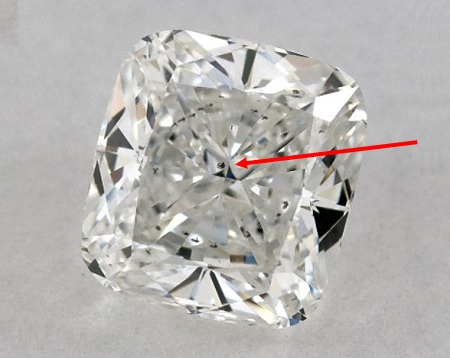

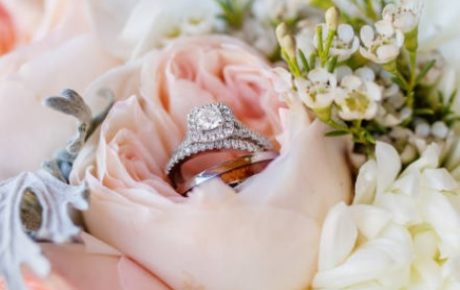
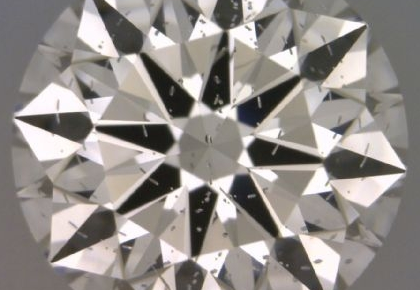
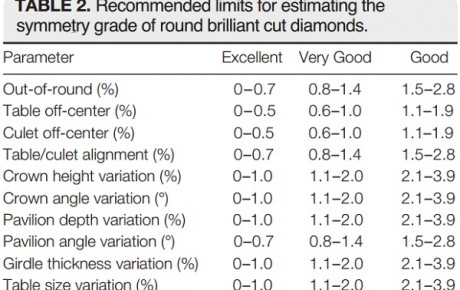









43 Comments
I am glad I’ve done my homework some what. In looking at a princess cut diamond for my girlfriend’s center stone, I have decided too buy the diamond and then pick a setting too her liking. Your information has made me think about buying online at Ebay.
Even though the seller has a 100% feedback rating since 2007, I am unsure if he can give me the ASET proof. As you have stated, what good is a bigger diamond if the light goes through it, or out to the side of the gem? I am going to look at loose stones at James Allen. After going through 2 marriages in my past, I never really did my diamond research. I hope the third one is a charm and I want her wearing the best.
Congrats and all the best for your upcoming marriage. Feel free to get in contact with me privately if you need further advice on your purchase.
Is there any reason why you recommend JamesAllen.com and not anywhere else? I’m just curious and wondering why other vendors can’t do the same as James Allen and why they can offer such a generous return policy and service. Sorry if I sound a little cynical but when I’m spending more than $4000 on a ring purchase, I want to make sure things are right.
It’s because of the video technology and intuitive website they created. Unlike other businesses, the parent company of JA actually developed the videography equipment and employed it in their business. And that’s the cool thing with JA. Not only do you get to see your diamond under magnification, you get hassle-free shopping with 30 days return policies.
While other vendors simply download a virtual list of diamonds from their suppliers, James Allen actually work with vendors near the premises of their New York office.
Due to the close proximity in which they can get diamonds called in, they have physically access to the diamonds they list. Since no shipping fee is involved, consumers get to enjoy the value added features for free.
Greetings,
I went through your website and wanted to buy diamonds from you, please let me know the fairest prices of VVS1 3 CARATS IN J SHADE and VSI- 1 CARAT IN H SHADE.
Warmest Regards
NA KHAN
I don’t sell diamonds. That’s how I keep my advice impartial. You can do your own comparisons of pricing using the information here: https://beyond4cs.com/diamond-prices/
Hi Paul,
Your website is awesome! I have learned more from you than any other educational site. What about negotiating price with vendors?
They must expect someone to offer less than asking price? What is reasonable without insulting them?
Thanks again, I congratulate you on your desire to master this industry and truthfully communicate it to the consumer
Paul
Research your own prices here: https://beyond4cs.com/diamond-prices/
And use it as a leverage. Don’t worry about “insulting” the jeweler. If they can’t compete on prices, you can always walk away and find another.
Hello Paul , you offer any kind of paid advices? Like help me to find the right diamond and I pay to you.
I don’t charge visitors a fee for asking questions or helping them pick a diamond. Feel free to email me in private with what you are looking for and I’ll try my best to address questions you have.
hi Paul,
I need your advise on selecting the most sparkling and fire between these two diamonds
G 2.4 carats vvs1 depth 62 and table 58 with triple Xs and medium fluorescence
E 2.3 carats IF depth 62.5 and table 57 triple Xs and strong flu
please be advise which will provide better firing or do you have any recommendation of a similar diamond
thank you
You need to read this: https://beyond4cs.com/buying-diamonds-blind/
Hi Paul, for the ideal cut oval diamond, most other websites recommend depth % around 57 to 61, while you recommend 62-67%. why?
Have you even read the content on Beyond4cs.com properly and fully understood it? I had never advocated shopping based on proportions alone when buying oval fancy cut diamonds. The numbers are just there as a guide and you definitely need videos to size up the diamond’s appearance.
Re-read again and you will have your answers.
Unfortunately, you should consider updating your blanket recommendation of James Allen. It seems they are holding a lot of their diamonds in India and cannot get ASET images of these diamonds. Only one out of four diamonds I asked about was in the New York office and available for ASET imaging.
Sorry about that. James Allen has been expanding their operations and had built up a larger inventory of diamonds from international suppliers. As things are at the moment, there is no quick fix but with experience, you can actually determine light performance from the videos alone without the need for an ASET. If you need help, just drop me a message in private and I’ll help you out.
I was searching for a cushion cut diamond via an online vendor and I noticed that “cut grades” were assigned to fancy cut diamonds in their inventory.
It perplexes me because some diamonds that fall within your recommended ideal proportions were actually graded “very good” whereas another seemingly similar diamond was graded as “excellent”.
When I looked at another vendor, the same thing happens. It seems like different vendors assign different cut grades to the fancy shapes. Are these diamonds given an objective evaluation by a gemologist or do they actually follow some standards in which the grades were assigned?
Thanks for leaving the comment.
When online vendors list their diamonds for sale, the stones are actually filtered and organized based on the individual vendor’s own set of standards. For example, one vendor might assign an Excellent cut grade to a princess diamond with 71% depth and 67% table while another vendor might assign a Very Good cut grade to the same diamond.
Next, the numbers and proportion charts found on our website are just guidelines we think nice looking fancies might fall in. There are really no hard and fast rules when it comes to selecting fancies. As we had mentioned in the tables, they are there merely to act as guidelines to help you out. And the truth is, we can’t place a figure to correlate a fancy’s visual beauty based on the table and depth proportions only.
Besides that, the polish and symmetry grading of a fancy is really unrelated to how the diamond will look in real life. Very often, you will find that a Very Good/Good diamond can look a lot better than another diamond with Excellent/Excellent polish and symmetry.
When buying fancies, the best way would be to see the stones in person. However, this is not a luxury many people can enjoy because most local jewelers don’t carry enough of them for you to cherry pick and to make good comparisons.
The next best option for you is to work with vendors who can help you take an ASET image of your shortlisted diamond. This ASET photograph can help you “determine” the diamond’s light performance and enables you to infer how it looks like in real life.
Hi Paul,
Thank you so much for all the educations! Otherwise, my boyfriend and I would never be able to pick a decent stone. We are thinking to purchase a 2 carat princess cut ring. I have a few options, and would love to pick up your brains. Thanks!!
https://www.jamesallen.com/loose-diamonds/princess-cut/2.00-carat-f-color-si1-clarity-sku-2160001
https://www.jamesallen.com/loose-diamonds/princess-cut/2.02-carat-h-color-vvs1-clarity-sku-1892156
https://www.jamesallen.com/loose-diamonds/princess-cut/2.02-carat-i-color-vvs2-clarity-sku-317561
Hello Paul,
I am looking for an oval diamond an have found this; https://www.jamesallen.com/loose-diamonds/oval-cut/0.91-carat-f-color-vs1-clarity-sku-2304906
Is there anything you could tell me based on this info? would you reckon its a good buy? Have understood that ovals are particularly difficult to buy unseen/online. Why doesn’t GIA rate fancy shape diamonds for their cut grading?
Thanks in advance for any input you may have!
Andreas
Unfortunately, GIA has not developed any cut grading system for fancy shaped diamonds. However, AGS has successfully researched and developed cut grading metrics for shapes like cushions, princess, emerald and oval cut diamonds.
I will say this: because of how strict AGS’s cut grading system is for fancy cut diamonds, most cutters won’t bother sending their diamonds to AGS for grading because it will result in an ugly looking report as AGS will ding and penalize the stones for mediocre performance. In order to make diamonds salable, they would send the junk to GIA for a generic report so that it looks better on paper.
This is how the system is being gamed in the real world and why you need to rely on tangible, scientific data when choosing a fancy cut diamond.
Anyway, I reviewed the listing and think you found a well cut oval and the stone is eyeclean. Well done!
I’m trying to find a cushion cut that has a larger spread to give the illusion of being bigger than it is! I found this on Blue Nile and am wondering if it’s any good? Any advice would be very much appreciated! Thank you! https://beyond4cs.com/go/bn-LD08099036/
It’s a well cut cushion. Great find!
Hello Paul i have a question
i just purchased a cushion cut diamond. Could you please look at this link and tell me is it a good choice ? https://www.jamesallen.com/loose-diamonds/cushion-cut/0.80-carat-f-color-vs1-clarity-sku-2304855
My only concern is the fluorescence faint or i need to look with NONe fluorescence
The fluorescence is not an issue I would be concerned with. Faint ratings will not change affect the appearance of the diamond in any manner. No worries there.
Since buying fancy shapes online is the recommended approach, do you have any recommendations or best practices when it comes to getting the diamond bought online set at a local jewelry store? I suppose my main concern is how to make sure the diamond doesn’t get switched out or anything while the ring is being made (heard stories, or at least suspicions), but I imagine there may be more issues or concerns I haven’t heard or thought of either.
Also, when looking at these images for diamonds online (e.g. at James Allen) I’m able to see a lot of marks on and in the diamond–marks I’m assuming I wouldn’t be able to see while looking at it normally? If so, how can I tell by looking at these pictures online that it will be eye clean? I read the section regarding this but didn’t follow how you made the conclusion that it was eye clean, except for the really obvious ones haha.
Finally, I noticed in the comment above that you mentioned you can get an idea of light performance based on the video alone. Could you explain that as well?
Thanks, and I appreciate all the help!
Mike, here are answers to your different questions…
1) Read: https://beyond4cs.com/questions-people-ask/ and https://beyond4cs.com/care-and-maintenance/how-to-avoid-diamond-switching/
2) https://beyond4cs.com/clarity/resize-technique/
3) Based on experience. Once you view enough diamonds in real life and correlating them to the video (plus idealscope/ASET), you will be able to do this as well.
Have been reading everything you have posted, I feel like I’m better qualified then any sales person I’ve been speaking with “thanks to you”.
Found these diamonds on ED:
STOCK # E184-524785054 // liked this one the most but they don’t have ASET for it. I’ll have to purchase it first (it’s in Chicago)
STOCK # E183-428683263 //
STOCK # E200-42Z414137 //
STOCK # E201-3062Z8453 //
My wife really like the Emerald cut, but I think the round is prettier.
Anyway the first one in the list don’t have a ASET and the person I spoke with at ED said I should wait for a better cut diamond, can’t see why he would say that.
Thanks in advance
Maurice
Maurice, the emerald cut diamond is pretty well cut: SKU 524785054. They could be curating their inventory to help you select a well cut diamond and don’t have anything nice in stock now.
As for the choice of shape, it would be wise for you to follow your wife’s preference.
Thank you so much for all of this information to help me make a better buying decision! I was told by my local jeweler, a certified GIA gemologist since 1976, not to trust any diamonds that come from Blue Nile or anything that you can’t look at personally. He said that he often rejects these “internet stones” that come in with the GIA reports which he claims are sometimes 1-3 levels off of what he would grade the same diamond. This makes me nervous about buying online and trusting the GIA report. Could this be true, or is this simply a sales technique to sway me from purchasing online? I think I have a decent grasp on the 4 C’s / ASET / Idealscope components to finding the perfect diamond thanks to your post! Is there anything else I should consider purchasing a princess cut? Thanks for your help!!
That’s a joke! If this “certified” GIA gemologist claims so, he or she is an idiot and out to rip you off. First of all, GIA certifies no one. Secondly, use your brain and think. Is a GIA report for a diamond SOLD by him different from a GIA report from an online vendor? It isn’t. Just do your research and you’ll know who is BSing you and who isn’t.
I have been looking for a 7 carat Radiant or Cushion VS2 F color eternity ring. Who would be your preferred seller?
This url will address your questions: https://beyond4cs.com/big-diamond-rings/
Hello,
I’m looking for a pear shaped diamond however I’m not sure what ratio to go with. Research online has indicated length to width ratio of 1.45-1.78 to be best although your recommendation is less than this. I don’t want the diamond to look to chubby or to skinny. Wondering what your thoughts are.
Thank you.
Length to width ratios are really up to personal preferences. Now, I would say that 1.75 for pear shape would make it completely lose its shape appeal. I generally recommend 1.33 – 1.40 if you want a nice outline for the stone.
Have you heard of blue nile? I’m from the UK and they do have very good prices and they have a ring design I love to get.
Yep. Blue Nile is the largest online diamond company in the world and they are a reliable place to shop at. When choosing diamonds, use the filter to select the ones that have 360 videos so that you see the diamond visually to assess it properly. You may also be interested in this review I’ve written about them.
If fancy cut diamonds require close up examination, wouldn’t a brick and mortar store be the best place to buy an engagement ring?
In an ideal world, the local brick and mortar store would be a place where you can check out their inventory in person. In reality, assuming that your local jewelers will carry these fancy shapes in stock is only going to lead to disappointment.
That’s because most physical stores cannot afford to hold inventory and they usually only carry a bigger amount of round diamonds which are easier to see due to popularity. Also, I’ve already explained the problems in details if you bothered to read write up.
Many local jewelers will get diamonds in on your request of size, shape etc. Seeing the diamond in person and comparing them is more important than the reports. You are buying a diamond because it’s beautiful not because it’s a G, VS1. This site gives lots of great information however to not look at diamonds in person w a qualified jeweler is limiting your options. BTW many online sellers don’t own their inventory and are marketing others goods.
Yep. That’s right. The color and clarity are just personal preferences. I have no problems with local jewelers IF they actually provide good service. The problem I have is that the majority have no idea about cut quality and behave as if they do. More importantly, they expect you to put down a non-refundable deposit just to bring in diamonds on request. That’s a big no no for me and it’s a scummy way to conduct business.
Thank you for your website as I have been reading it daily and learning so much.
I am looking at upgrading my current diamond (.57ct round) but want to keep my current set (three 4mm bands with prong set diamonds) that is about 33yrs old. I have purchased a loose diamond from a brick and mortar store before and now realized that I was not an informed buyer. I am trying to avoid the same mistake twice. Any input and advice would be appreciated.
Would an emerald (love the look), radiant or cushion (concerned about bow tie effect and crushed ice look), would be okay or do I have to stay with a round?
What would be a good size ct or mm? I have short chubby fingers.
Despite looking at all the information you have provided I still can’t tell what to look for.
I am going to be in the Houston area in Feb and have been in contact with Brian Gavin about going to their location to view some stones. What would you recommend I look for? Should I have them bring in stuff from their Virtual Store or just look at what they have on hand from their Signature lines?
When I put in the depth/table % recommendations for emerald, radiant or cushions, their Signature lines show no hits. Does this mean that their Signatures lines are not worth the premium price?
Is the extra money for their Signature lines worth it?
You recommend Brian Gavin so I was wondering what your thoughts are and if you could give me some help.
Thank you,
Marie Crostley
The shape of a diamond is completely up to personal preferences. If you like the emerald cut, that would be the one to go for. Similarly, carat size is up to individual preferences and 1 carat is the magical mark that many people aspire to own.
I do have an article written up on finger shapes and how it can get affected by the ring style. With Brian Gavin, you should ONLY look within their signature collections and their inhouse emerald cuts are fantastic. Those are cut for the best light return. Proportions are just a guideline as I have clearly and EXPLICITLY stated for fancy shapes. What matters most are the tangible data like videos and scope data which reveals light performance.